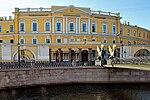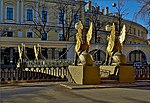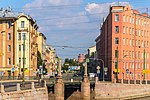Saint Petersburg State University of Economics and Finance

Saint Petersburg State University of Economics and Finance (Санкт-Петербургский государственный университет экономики и финансов) was a public university in Saint Petersburg, Russia. It was established in 1930 as Leningrad Institute of Finance and Economics (Ленинградский финансово-экономический институт; hence the colloquial name Финэк (Finec)). In 2012, it united with Saint Petersburg State University of Service and Economics and Saint Petersburg State University of Engineering and Economics to create Saint Petersburg State University of Economics. The campus of the University occupies the buildings of the former Assignation Bank, which were designed by the Italian architect Giacomo Quarenghi.
Excerpt from the Wikipedia article Saint Petersburg State University of Economics and Finance (License: CC BY-SA 3.0, Authors, Images).Saint Petersburg State University of Economics and Finance
Думская улица, Saint Petersburg Apraksin Dvor (округ № 78)
Geographical coordinates (GPS) Address Website Nearby Places Show on map
Geographical coordinates (GPS)
| Latitude | Longitude |
|---|---|
| N 59.9313 ° | E 30.3264 ° |
Address
Санкт-Петербургский государственный экономический университет
Думская улица
191011 Saint Petersburg, Apraksin Dvor (округ № 78)
Saint Petersburg, Russia
Open on Google Maps











